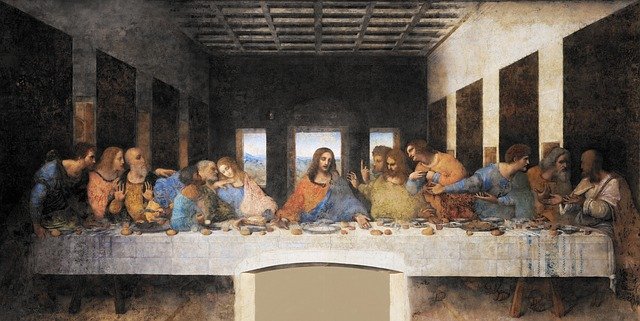
Church of Santa Maria delle Grazie – The Last Supper
In the refectory of the convent adjacent to the Milanese Sanctuary of Santa Maria delle Grazie, there is one of the absolute masterpieces of art. We are talking about the famous Last Supper, a wall painting obtained with a mixed dry technique on plaster, dating back to the years 1494-1498, and realized by Leonardo da Vinci on commission of Ludovico il Moro.
There are many curiosities about this work. Let’s discover some of them.
First of all: the table. Leonardo chose to set the most famous dinner in the world in Milan in the 15th century. The table where Jesus and the apostles sit, as well as the utensils and tablecloths, were painted taking as a model those of the refectory of Santa Maria delle Grazie. In this way, the table of the Cenacolo became to all intents and purposes one of the tables of the refectory and Christ and the apostles dined together with the Dominican monks of Santa Maria delle Grazie.
Let’s move on to the technique. What few people know is that the Last Supper began to deteriorate a few years after its completion. Leonardo used a very scrupulous and particular technique to paint it. He used fat tempera after having spread with hot irons a mixture of mastic and pitch to obtain a completely smooth background, and a thin layer of white lead and yellow clays. Precisely because of the procedure used, the color dried very quickly. Due to the humidity of the refectory, the fresco quickly began to deteriorate and required restoration. It is only thanks to the restoration of 1977 that today we can admire the Last Supper. Those who intervened on the fresco before then did nothing but worsen the situation.
And what about the Apostles? As everyone knows, Leonardo was a profound scholar of astrology and occultism. For this reason, the Last Supper can also be read as a representation of the solar system and the zodiac, where each apostle is painted according to the archetypal characteristics of the astral sign to which he corresponds. According to this view, the apostle Peter is in the position of Jupiter and Sagittarius, while Thomas is instead painted in correspondence with the planet Mercury and the sign of Virgo. Judas instead would be Scorpio, in the position of Mars, an unfaithful sign that represents disintegration and death; for this reason his fingers are contracted, like the pincers of the scorpion ready to attack. Finally, Jesus would represent the Sun that with its divine light illuminates the scene and the universe.
Did you like this curiosity? If you want to discover the secrets, legends and mysteries of Milan, download the app of curiosities. Download Secret Maps!
And if you want to listen to something interesting, try the first Travel Podcast Platform. Try Loquis!

